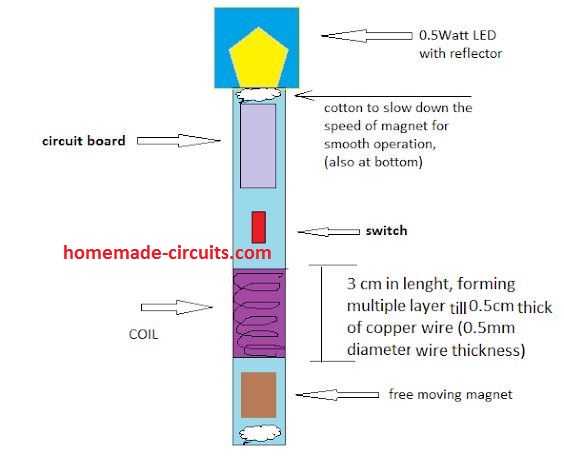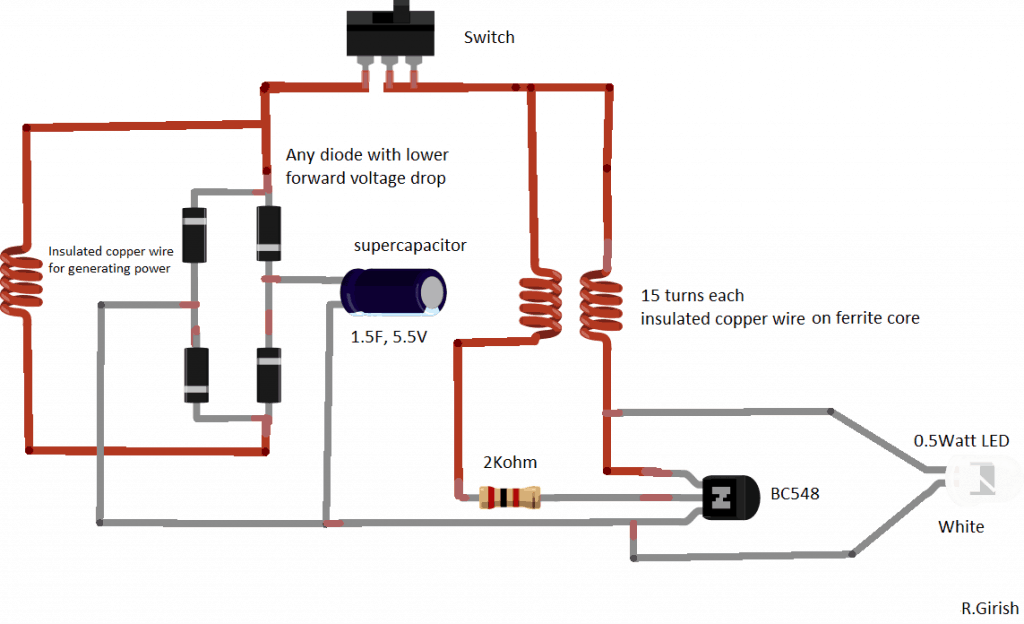In this article I will show how to construct a Faraday flashlight circuit using only a coil/magnet assembly which requires no battery. It’s not free energy, but it converts oscillatory motion to electricity, which can power the flashlight for a couple of minutes. This flashlight will be useful in emergency situations where no access to electricity or batteries.
Construction Details:
The principle used in this flashlight design was first discovered by Michael Faraday, when he proved that when a magnet was moved within a coiled conductor, electricity was generated in the conductor.
The same concept is implemented in this design wherein a magnet is rapidly moved within a copper coil forcing electrons to flow through the wire and generating the required electricity for the LED illumination. In this design we go a step further and enhance it with a joule thief circuit and a super capacitor to produce higher amount of sustained glow on the LED.
The heart of this enhanced Faraday flashlight circuit is the supercapacitor which can charge and discharge at greater rate than traditional rechargeable batteries. The power is generated by oscillatory motion by our hand, which will move magnets to and fro, which induces potential on the coil.
Circuit Diagram

The voltage induced in the coil is fed to supercapacitor, charges and illuminates a 0.5 Watt LED for couple of minutes. A PVC pipe or similar can be used for flashlight’s body, but make sure it’s made of sturdy material and will not wear and tear easily.
A cotton ball or similar soft material should be placed on top and bottom of the flashlight for smooth stopping of the magnet while charging the torch.
The magnets are round neodymium magnets stacked one another which give cylindrical form, around 10 of them are sufficient.
Coil specification:
The coil is vital part of the crank flashlight circuit which charges the supercapacitor. Try to make neat as possible.
• The coil should be enameled copper wire with 0.5mm in diameter.
• The coil should be wounded 3 cm across the tube, and make it 0.5 cm thick with multiple layers.
• Make sure the coil stays tight and protect it with insulation tape or something similar.
The supercapacitor alone is not enough to light a LED, the voltage may drop soon and remaining energy stored in the capacitor stay unused. So we are going to utilize joule thief circuit, which boost up the remaining power in the supercapacitor, which gives extra life to LED.
The Design:
The proposed Faraday flashlight circuit consists of generator coil which is static, and generates power for the supercapacitor. The induced voltage is alternating current due to oscillatory motion; a bridge rectifier is utilized for converting to DC voltage for charging supercapacitor. This circuit summarizes the charging circuit.

The LED driver circuit is a normal joule thief circuit, which takes low voltage from the supercapacitor and boosts it up for the LED.
For longer LED illumination use couple of standard 0.5mm white LEDs in series instead of one 0.5 Watt led.
Make sure to switch off the flashlight before shaking it (charging).
Do not use supercapacitor with greater than 1.5 Farad as it may take longer charging duration and may be not suitable for this project. Make sure the voltage rating is around 5.5V, using lower value may overcharge the capacitor.
Parts List
- 1 no 1/2 watt 3.3 V LED or you can also try a 20 mA 3.3 V high bright LED for lower consumption and high brightness even with slow shaking.
- 1 no 2.2 k resistor 1/4 watt
- Alternator coil shown on the left side is built by winding many layers super enameled copper wire over a 12 mm diameter 30 mm long plastic former, until the total thickness of the wire layers become 5 mm thick over the former. The wire gauge or thickness can be 0.3 mm.
- The right side joule thief coil could be built by winding two separate turns over a small ferrite ring core. The wire can be super enameled copper wire 0.3 mm thick. Remember while joining the two winding with the transistor circuit, there could be a polarity issue. A wrong polarity will prevent the LED from glowing, if this happen, you can simply try swapping the winding connections on the 2k resistor side, and this will immediately solve the problem.
- 1 no transistor BC548 or BC547
- 4 nos 1N4148 diodes.
- 1 no super capacitor, or you can initially try an ordinary 100uF / 10V capacitor also.
- 1 no Neodymium cylinder magnet, 10mm dia. x 15mm thick
- 1 no ON/OFF switch which is optional
what is the bill of material?
You can find it under the “parts list”
Waw it is awesome please I will like you to help me in this.
Dear Swagatam,
Do you have supply list for your Simple Faraday Flashlight project? This looks like something my WEBELOS would enjoy building this year in Scouts, but I don’t know enough about the different components in order to build a supply list myself. Thanks for your help and your willingness to spread your knowledge about this subject.
Thanks James, I have tried to update an appropriate parts list at the end of the post, please check it out.
Hello Swagatam,
Its pleasure to learn from your practical circuits.
I have seen you providing solution to many hobbyists, please help me with one.
I am planning for a circuit which basically prioritizes the inputs.
Consider i have 2 inputs (AC 220V 50Hz mains) from different sources. I plan a circuit which would prioritize P1 over P2 i.e. when P1 is available, the output relay would close the relay to pass P1 at the output, and when P1 is unavailable, P2 would be connected to output.
I tried to design it by simply dropping P1 to 5 to 9 V DC and use this signal to control SPDT relay, but i am worried if that would be practical enough. I am unsure what components i should go with and being mains i am bit worried too.
Request you to design some feasible solution that would provide above function safely and remains feasible not even in preparation cost but runtime power consumption. Also, if it could take care of minor voltage drops at P1 input, i mean it should not keep switching in loop when P1 voltage drops.
Can we add some smoothing circuit at output so the load devices connected at output do not feel the switching transition. I am expecting not much but say 300 to 400 watt load at output.
Thank you for all your help and suggestions.
Thank you Puneet,
The relay approach is the easiest and the recommended one, so what you have done seems to be correct.
For further info you can refer to the following post:
https://www.homemade-circuits.com/2012/09/automatic-inverter-supply-and-mains.html
please see only the DPDT relay section and its wiring, other details can be ignored.
Using a DPDT will ensure a better isolation across the two mains sources.
you can also refer to the following related post
https://www.homemade-circuits.com/2014/06/how-to-convert-inverter-to-ups.html
Hello Swagatam,
That was quite quick! I really appreciate you turned out so quick 🙂
I believe 4.bp.blogspot.com/-p5D8vjC8fd8/U6ukQUa3c3I/AAAAAAAAHXI/uIwZOBmpAXk/s1600/inverter+to+UPS.png has the answer (ignoring battery charger part)
In the side note you have suggested to add 1k resistor across bridge smoothing filter capacitor for quick discharge which would enhance switching response time. I was just wondering if instead of relay we use SSR (https://www.homemade-circuits.com/2011/12/efficient-electronic-relay-ssr-circuit.html), or would it be an overkill.
Thank you
Puneet
thanks Puneet,
the SSR circuit will not work like a SPDT or DPDT relay so anyway it cannot be applied for your requirement. A good quality relay is the only option which could be expected to do the job perfectly, using the diagram which you have preferred.
….or perhaps the following design could be also tried (only the triac section)
https://www.homemade-circuits.com/2015/12/invertermains-ac-changeover-circuit.html
Thank you Swagatam.
That helps a lot 🙂
you are welcome!